Abstract
We describe the induction of autoimmune diabetes, insulitis, and thyroiditis in athymic rats following injections of major histocompatibility complex compatible spleen cells. Lymphocytes with these capabilities were found in normal rats of the YOS, WAG, PVG, and diabetes-resistant BB strains, and in diabetes-prone BB rats. Adoptive transfer was facilitated by prior in vivo depletion of RT6.1+ regulatory T cells and in vitro mitogen activation of donor spleen cells. By RT6 depleting diabetes-resistant donors and using nude recipients, transfer of diabetes and thyroiditis was accomplished by using fresh, unstimulated spleen cells. The data suggest that organ-specific autoreactive cells may be present to various degrees but suppressed to a variable extent in many rat strains. The equilibrium between autoreactive and regulatory cells appears to determine the expression of autoimmunity.
Full text
PDF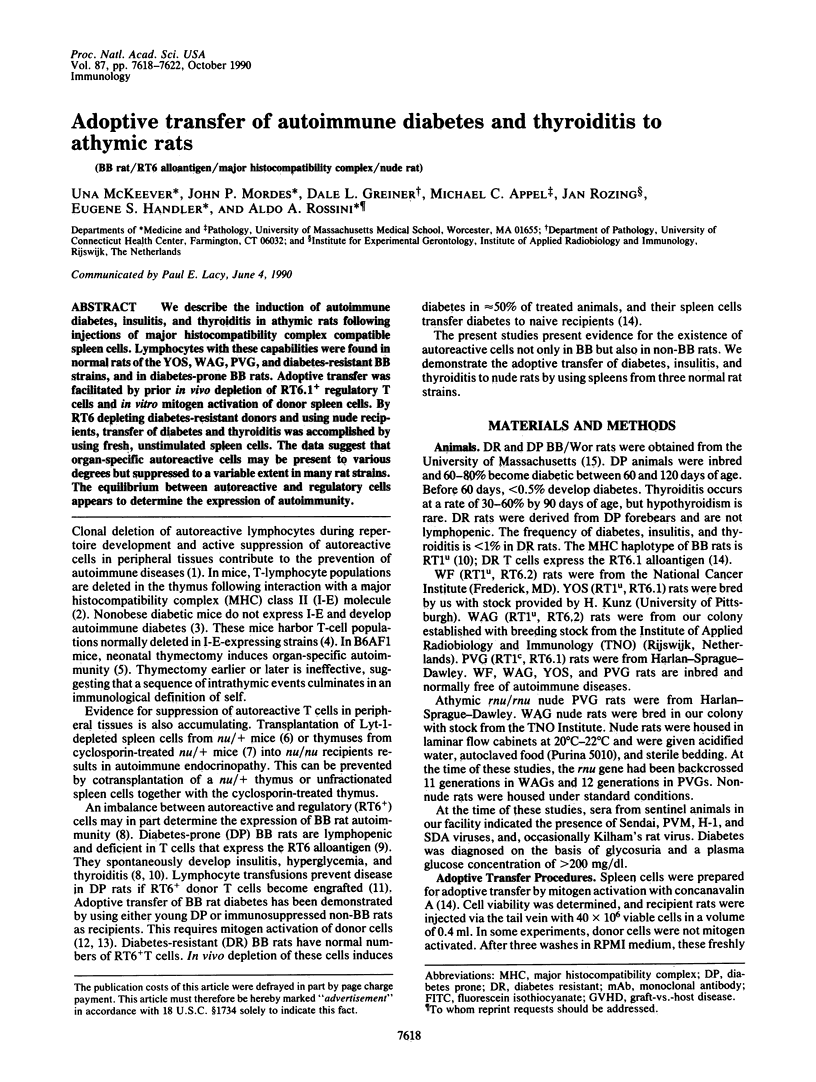
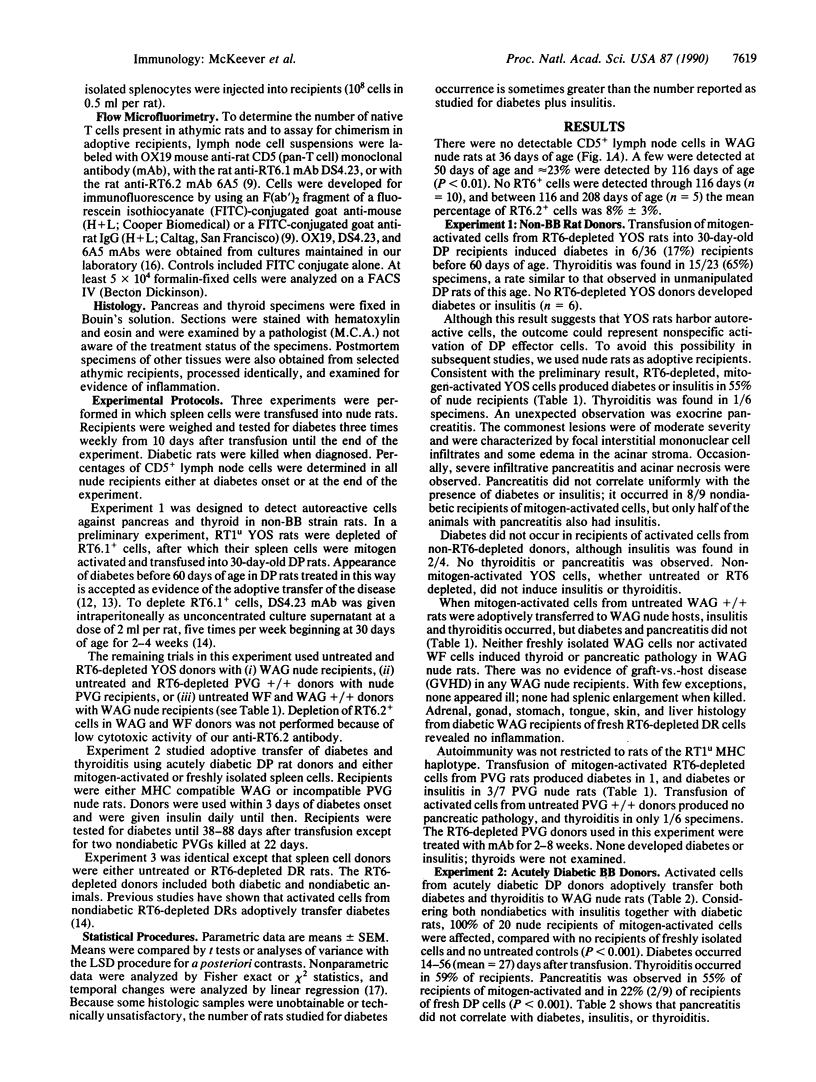
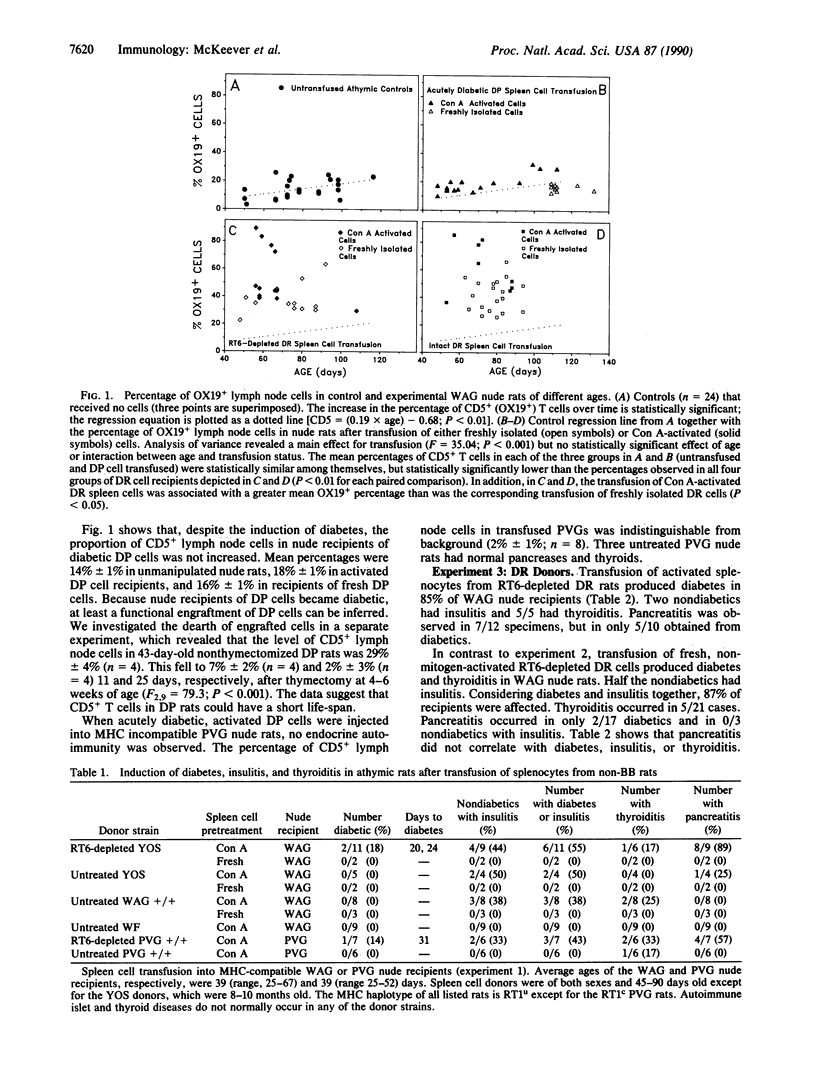
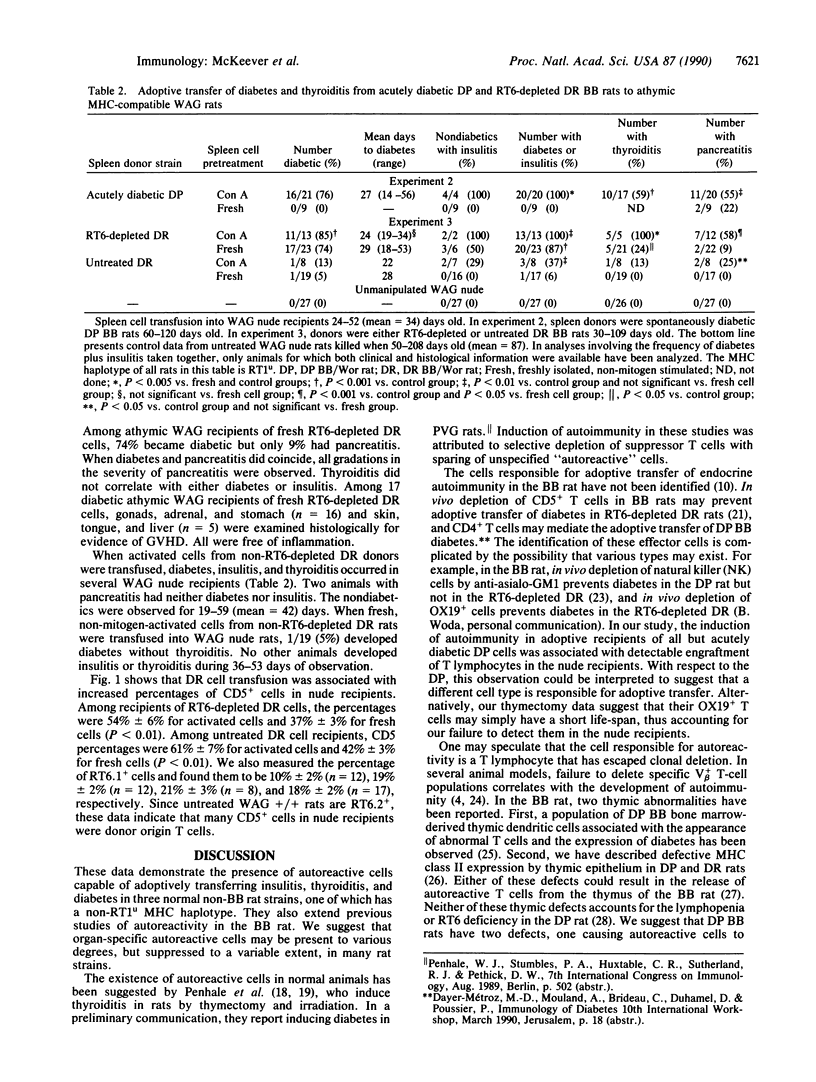
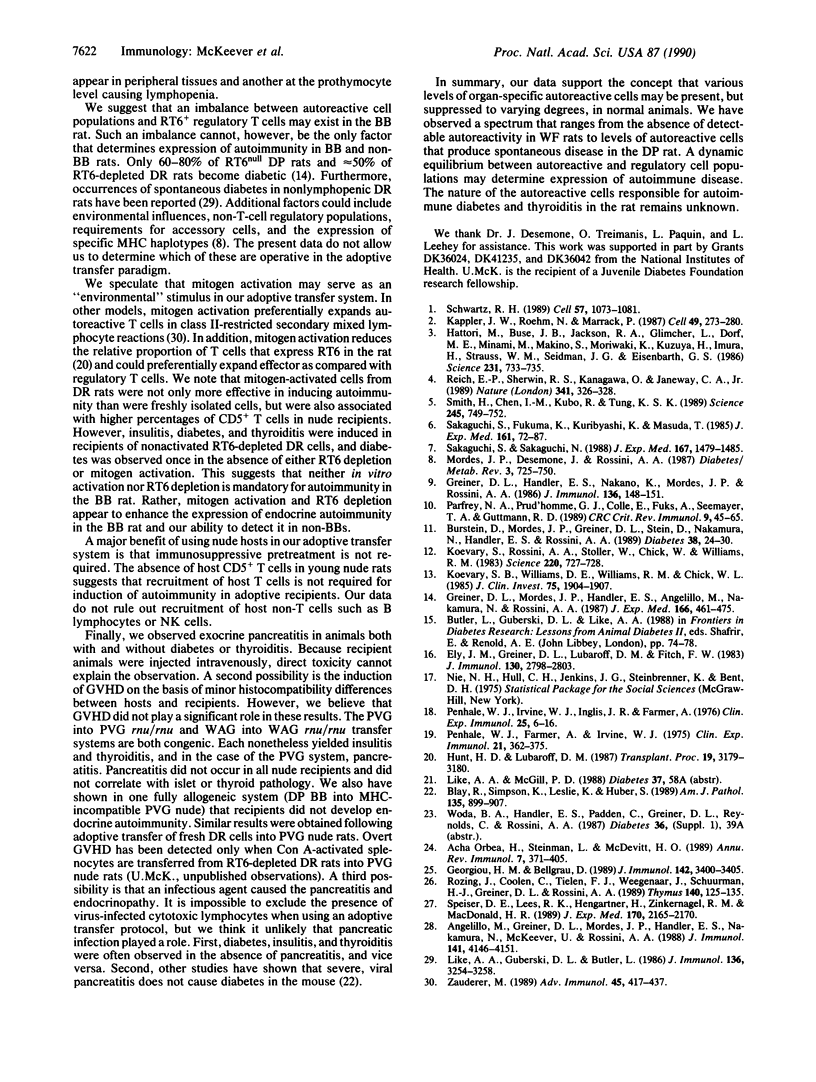
Selected References
These references are in PubMed. This may not be the complete list of references from this article.
- Acha-Orbea H., Steinman L., McDevitt H. O. T cell receptors in murine autoimmune diseases. Annu Rev Immunol. 1989;7:371–405. doi: 10.1146/annurev.iy.07.040189.002103. [DOI] [PubMed] [Google Scholar]
- Angelillo M., Greiner D. L., Mordes J. P., Handler E. S., Nakamura N., McKeever U., Rossini A. Absence of RT6+ T cells in diabetes-prone biobreeding/Worcester rats is due to genetic and cell developmental defects. J Immunol. 1988 Dec 15;141(12):4146–4151. [PubMed] [Google Scholar]
- Blay R., Simpson K., Leslie K., Huber S. Coxsackievirus-induced disease. CD4+ cells initiate both myocarditis and pancreatitis in DBA/2 mice. Am J Pathol. 1989 Nov;135(5):899–907. [PMC free article] [PubMed] [Google Scholar]
- Burstein D., Mordes J. P., Greiner D. L., Stein D., Nakamura N., Handler E. S., Rossini A. A. Prevention of diabetes in BB/Wor rat by single transfusion of spleen cells. Parameters that affect degree of protection. Diabetes. 1989 Jan;38(1):24–30. doi: 10.2337/diab.38.1.24. [DOI] [PubMed] [Google Scholar]
- Ely J. M., Greiner D. L., Lubaroff D. M., Fitch F. W. Characterization of monoclonal antibodies that define rat T cell alloantigens. J Immunol. 1983 Jun;130(6):2798–2803. [PubMed] [Google Scholar]
- Georgiou H. M., Bellgrau D. Thymus transplantation and disease prevention in the diabetes-prone Bio-Breeding rat. J Immunol. 1989 May 15;142(10):3400–3405. [PubMed] [Google Scholar]
- Greiner D. L., Handler E. S., Nakano K., Mordes J. P., Rossini A. A. Absence of the RT-6 T cell subset in diabetes-prone BB/W rats. J Immunol. 1986 Jan;136(1):148–151. [PubMed] [Google Scholar]
- Greiner D. L., Mordes J. P., Handler E. S., Angelillo M., Nakamura N., Rossini A. A. Depletion of RT6.1+ T lymphocytes induces diabetes in resistant biobreeding/Worcester (BB/W) rats. J Exp Med. 1987 Aug 1;166(2):461–475. doi: 10.1084/jem.166.2.461. [DOI] [PMC free article] [PubMed] [Google Scholar]
- Hattori M., Buse J. B., Jackson R. A., Glimcher L., Dorf M. E., Minami M., Makino S., Moriwaki K., Kuzuya H., Imura H. The NOD mouse: recessive diabetogenic gene in the major histocompatibility complex. Science. 1986 Feb 14;231(4739):733–735. doi: 10.1126/science.3003909. [DOI] [PubMed] [Google Scholar]
- Kappler J. W., Roehm N., Marrack P. T cell tolerance by clonal elimination in the thymus. Cell. 1987 Apr 24;49(2):273–280. doi: 10.1016/0092-8674(87)90568-x. [DOI] [PubMed] [Google Scholar]
- Koevary S. B., Williams D. E., Williams R. M., Chick W. L. Passive transfer of diabetes from BB/W to Wistar-Furth rats. J Clin Invest. 1985 Jun;75(6):1904–1907. doi: 10.1172/JCI111904. [DOI] [PMC free article] [PubMed] [Google Scholar]
- Koevary S., Rossini A., Stoller W., Chick W., Williams R. M. Passive transfer of diabetes in the BB/W rat. Science. 1983 May 13;220(4598):727–728. doi: 10.1126/science.6836309. [DOI] [PubMed] [Google Scholar]
- Like A. A., Guberski D. L., Butler L. Diabetic BioBreeding/Worcester (BB/Wor) rats need not be lymphopenic. J Immunol. 1986 May 1;136(9):3254–3258. [PubMed] [Google Scholar]
- Mordes J. P., Desemone J., Rossini A. A. The BB rat. Diabetes Metab Rev. 1987 Jul;3(3):725–750. doi: 10.1002/dmr.5610030307. [DOI] [PubMed] [Google Scholar]
- Parfrey N. A., Prud'homme G. J., Colle E., Fuks A., Seemayer T. A., Guttmann R. D., Ono S. J. Immunologic and genetic studies of diabetes in the BB rat. Crit Rev Immunol. 1989;9(1):45–65. [PubMed] [Google Scholar]
- Penhale W. J., Farmer A., Irvine W. J. Thyroiditis in T cell-depleted rats. Influence of strain, radiation dose, adjuvants and antilymphocyte serum. Clin Exp Immunol. 1975 Sep;21(3):362–375. [PMC free article] [PubMed] [Google Scholar]
- Penhale W. J., Irvine W. J., Inglis J. R., Farmer A. Thyroiditis in T cell-depleted rats: suppression of the autoallergic response by reconstitution with normal lymphoid cells. Clin Exp Immunol. 1976 Jul;25(1):6–16. [PMC free article] [PubMed] [Google Scholar]
- Reich E. P., Sherwin R. S., Kanagawa O., Janeway C. A., Jr An explanation for the protective effect of the MHC class II I-E molecule in murine diabetes. Nature. 1989 Sep 28;341(6240):326–328. doi: 10.1038/341326a0. [DOI] [PubMed] [Google Scholar]
- Rozing J., Coolen C., Tielen F. J., Weegenaar J., Schuurman H. J., Greiner D. L., Rossini A. A. Defects in the thymic epithelial stroma of diabetes prone BB rats. Thymus. 1989;14(1-3):125–135. [PubMed] [Google Scholar]
- Sakaguchi S., Fukuma K., Kuribayashi K., Masuda T. Organ-specific autoimmune diseases induced in mice by elimination of T cell subset. I. Evidence for the active participation of T cells in natural self-tolerance; deficit of a T cell subset as a possible cause of autoimmune disease. J Exp Med. 1985 Jan 1;161(1):72–87. doi: 10.1084/jem.161.1.72. [DOI] [PMC free article] [PubMed] [Google Scholar]
- Sakaguchi S., Sakaguchi N. Thymus and autoimmunity. Transplantation of the thymus from cyclosporin A-treated mice causes organ-specific autoimmune disease in athymic nude mice. J Exp Med. 1988 Apr 1;167(4):1479–1485. doi: 10.1084/jem.167.4.1479. [DOI] [PMC free article] [PubMed] [Google Scholar]
- Schwartz R. H. Acquisition of immunologic self-tolerance. Cell. 1989 Jun 30;57(7):1073–1081. doi: 10.1016/0092-8674(89)90044-5. [DOI] [PubMed] [Google Scholar]
- Smith H., Chen I. M., Kubo R., Tung K. S. Neonatal thymectomy results in a repertoire enriched in T cells deleted in adult thymus. Science. 1989 Aug 18;245(4919):749–752. doi: 10.1126/science.2788921. [DOI] [PubMed] [Google Scholar]
- Speiser D. E., Lees R. K., Hengartner H., Zinkernagel R. M., MacDonald H. R. Positive and negative selection of T cell receptor V beta domains controlled by distinct cell populations in the thymus. J Exp Med. 1989 Dec 1;170(6):2165–2170. doi: 10.1084/jem.170.6.2165. [DOI] [PMC free article] [PubMed] [Google Scholar]
- Zauderer M. Origin and significance of autoreactive T cells. Adv Immunol. 1989;45:417–437. doi: 10.1016/s0065-2776(08)60698-7. [DOI] [PubMed] [Google Scholar]


